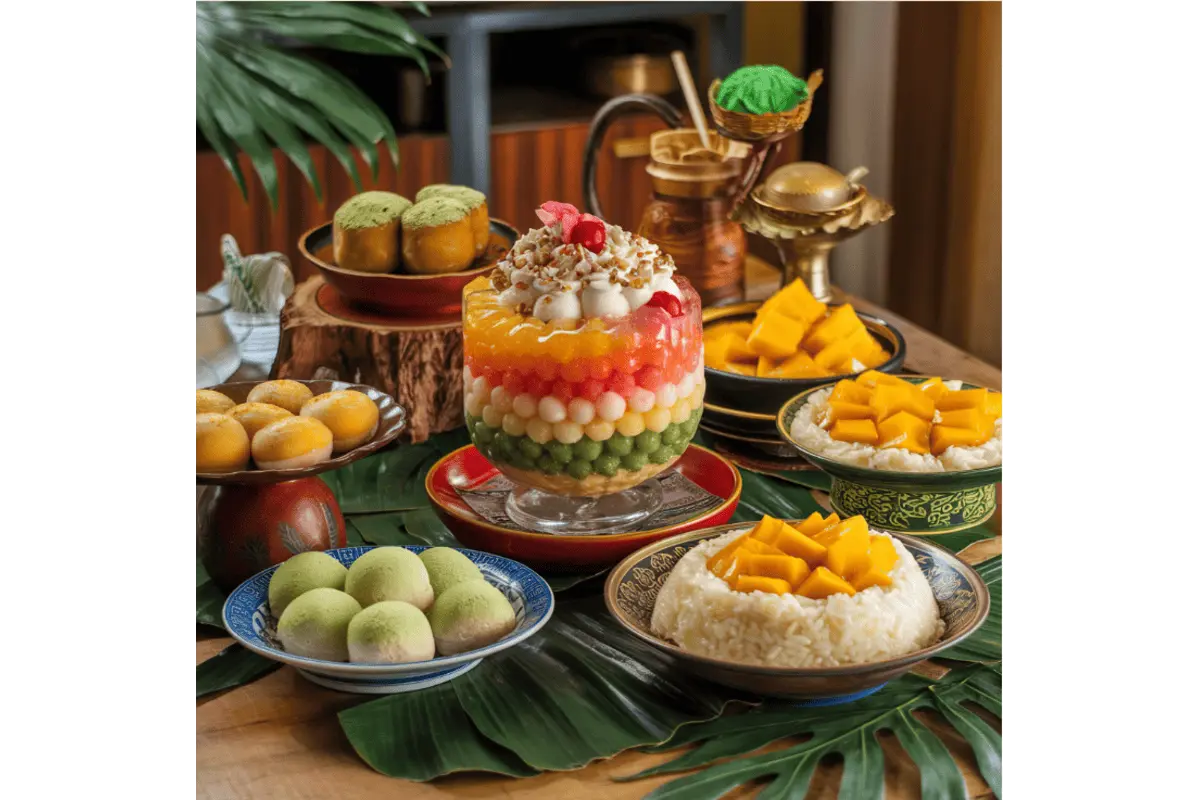Asian desserts are a beautiful blend of flavors, textures, and cultural history. Each sweet treat tells its own story, showcasing a region’s unique culinary traditions and heritage. Moreover, the variety is astounding—from the chewy, gooey delights of Japanese mochi to the indulgently rich Indian gulab jamun, every dessert offers a new experience. Therefore, exploring Asian desserts is not just about satisfying your sweet tooth; it is about immersing yourself in centuries of artistry and tradition.
If you are curious about how culinary traditions evolve into modern creations, check out the Ultimate Guide to the Dubai Chocolate Bar Recipe. It beautifully highlights the fusion of traditional techniques with contemporary innovation.
Part 1: A World of Flavors
East Asia: Subtle Elegance
East Asian desserts prioritize balance and simplicity. They often use subtle flavors and light textures that leave a lasting impression.
- Japan: Mochi is a chewy rice cake that can be stuffed with various fillings such as sweetened red bean paste or creamy ice cream. Additionally, seasonal variations like sakura mochi bring fresh, floral flavors to the forefront.
- China: Egg tarts combine a flaky pastry crust with smooth custard filling, perfectly blending Western influences with Cantonese flair. Furthermore, they are often enjoyed as part of dim sum feasts.
- Korea: Hotteok, a pancake stuffed with brown sugar, cinnamon, and nuts, is a comforting treat that pairs wonderfully with hot tea during the winter months.
For more inspiration on combining flavors, explore the Carnitas Breakfast Recipe, which balances sweet and savory.
Southeast Asia: Vibrant and Tropical
Southeast Asia is known for its bold flavors and colorful presentations. Because the region has an abundance of tropical fruits and coconut-based ingredients, the desserts are naturally sweet and aromatic.

- Philippines: Halo-halo is a masterpiece of layers, including shaved ice, sweetened beans, ube, leche flan, and evaporated milk. This medley is as refreshing as it is indulgent.
- Thailand: Mango sticky rice is a well-loved dessert that combines sweet, ripe mangoes with creamy coconut milk-soaked rice. As a result, it achieves a perfect balance of richness and natural sweetness.
- Vietnam: Che Ba Mau, or “Three-Color Dessert,” uses layers of pandan jelly, mung beans, and coconut milk, creating a visually striking and deliciously satisfying treat.
If you’re looking for nutritious and kid-friendly dessert options, check out Nutritious Pudding Recipes for Kids.
South Asia: Rich and Indulgent
South Asian desserts are characterized by their decadence. Often using ingredients like ghee, condensed milk, and aromatic spices, these treats are undeniably indulgent.
- India: Kulfi, a frozen dessert similar to ice cream but denser, is often flavored with pistachios, saffron, or mango. Moreover, it is traditionally slow-cooked, enhancing its deep, caramelized flavor.
- Pakistan: Jalebi, golden spirals of fried batter soaked in sugar syrup, is a popular street snack that combines crispiness with an irresistibly sticky sweetness.
- Bangladesh: Chomchom, made from condensed milk, is often coated with coconut flakes, offering a delightful contrast of textures.
Part 2: The Role of Desserts in Culture
Celebrations and Traditions
Desserts play a crucial role in Asian celebrations. For example:
- During Lunar New Year in China, sticky rice cakes (nian gao) symbolize prosperity and familial unity.
- In India, sweets like laddoos and barfis are prepared in abundance during Diwali to celebrate the triumph of light over darkness.
Because these desserts often carry symbolic meanings, they are more than just indulgences—they represent hope, joy, and blessings.
Street Food Favorites
Across Asia, bustling streets and markets come alive with vendors selling a variety of desserts. For instance:
- In Indonesia, pisang goreng (fried bananas) offers a crispy exterior with a soft, sweet interior, making it a beloved snack for all ages.
- Similarly, in Vietnam, che desserts are available in endless varieties, from sweet soups to refreshing drinks, ensuring there is something for everyone.
For more creative dessert combinations, you might enjoy exploring the Dessert Platter Guide, which showcases ways to mix traditional and modern treats.
Part 3: Recipes You Can Try at Home
Beginner-Friendly Recipes
If you are new to making Asian desserts, don’t worry! There are plenty of simple recipes to get you started.
- Mango Sticky Rice
- Ingredients: Glutinous rice, ripe mangoes, coconut milk, sugar.
- Instructions: Steam the rice, mix with sweetened coconut milk, and serve alongside sliced mangoes for a beautifully balanced dessert.
- Coconut Jelly
- Ingredients: Coconut water, agar-agar, sugar.
- Instructions: Heat the ingredients, pour into molds, and refrigerate until set. As a result, you’ll have a refreshing and healthy dessert.
Advanced Recipes for the Adventurous
If you’re ready to elevate your skills, these intricate desserts are worth the effort.
- Mooncakes: Traditionally served during the Mid-Autumn Festival, these Chinese pastries feature a rich filling like lotus seed paste or red bean. Additionally, salted egg yolks are often added for a savory contrast.
- Kuih Lapis: This multi-layered steamed cake from Southeast Asia uses pandan and coconut milk. Achieving its signature stripes requires patience and precision.
Part 4: Frequently Asked Questions
Why are Asian desserts unique?
Asian desserts often use local ingredients like pandan leaves, coconut, and palm sugar, giving them distinctive flavors. Furthermore, their focus on textures—whether chewy, sticky, or creamy—sets them apart from Western desserts.
Are these desserts vegan-friendly?
Many Asian desserts are naturally vegan, as they rely on plant-based ingredients like coconut milk, rice, and fruit. However, it is always a good idea to check recipes for specific adaptations.
What’s an easy dessert to try first?
For beginners, mango sticky rice is an excellent choice. It requires minimal ingredients and delivers a perfect blend of sweetness and creaminess.
Part 5: Elevate Your Experience
Asian desserts are best enjoyed with complementary beverages. Pair mochi with green tea for a serene experience, or savor gulab jamun with chai for a warm, spiced indulgence.
For additional ideas and pairings, visit the Ultimate Guide to Italian Christmas Desserts, where you’ll find even more inspiration for creating memorable dessert moments.
Conclusion
Asian desserts are more than just treats—they are gateways to understanding the region’s rich culture and culinary creativity. From the vibrant flavors of tropical Southeast Asia to the subtle elegance of Japanese sweets, these desserts offer something for everyone. Whether you are enjoying them at a street market or recreating them at home, each bite tells a story of tradition, innovation, and community.
For more ideas and inspiration, discover creative recipes in CrispFreshRecipes. The possibilities are endless, and the journey is as sweet as the desserts themselves. Happy cooking and indulging!


2 thoughts on “The Ultimate Guide to Asian Desserts”